This section contains the detailed formulation
of a weighted three stage period analysis
for the simple model of Sect. 2.1.
The input data
![]() at
at
![]() are
are ![]() (time),
(time),
![]() (observation)
and
(observation)
and
![]() (error),
i.e. the weights are
(error),
i.e. the weights are ![]() ,
where
,
where
![]() .
The
.
The ![]() free parameters (
free parameters (
![]() )
for our K:th order model
)
for our K:th order model
The order K (Eq. 1) determines the PSch "model''
![]() (Eq. (2) below).
The PSch searches for the best period "candidates'' over a long
interval between
Pmin (
fmax-1)
and
Pmax (
fmin-1).
Typical correlation lengths in time
(
Dmin,
Dmax)
and phase (
(Eq. (2) below).
The PSch searches for the best period "candidates'' over a long
interval between
Pmin (
fmax-1)
and
Pmax (
fmin-1).
Typical correlation lengths in time
(
Dmin,
Dmax)
and phase (![]() )
are
)
are
![]() ,
,
![]() ,
and
,
and
The PSch uses four sets of
![]() pairs:
ti,j,
yi,j,
wi,j and
pairs:
ti,j,
yi,j,
wi,j and
![]() (
(
![]() and
and
![]() ).
The first three,
).
The first three,
![]() ,
,
![]() and
and
![]() ,
are independent of f,
but the
,
are independent of f,
but the
![]() are not.
The PSch periodogram determined at all integer multiples of
are not.
The PSch periodogram determined at all integer multiples of
![]() between
fmin and
fmax is
between
fmin and
fmax is
 |
(5) |
This algorithm divides the data into J bins with respect to
the time differences ti,j
between
Dmin and
Dmax.
The original ti,j, yi,j and wi,j
data are replaced by the J averages
t'q, y'q and w'q
within these bins.
The algorithm is efficient, because the Z function in Eq. (6)
has to applied only to J (![]() )
values at each tested f.
)
values at each tested f.
The yi,j differences closer than ![]() in
in
![]() are smaller for a good f candidate, i.e.
the data form a continuous curve.
Such f minimize the PSch periodogram
(Eqs. 3 or 6),
the case being opposite for poor f candidates.
Because
W(ti,j) (Eq. 4)
excludes yi,j too far in ti,j,
phase shifts during
time intervals longer than
Dmax
do not influence the periodogram.
The combination of
are smaller for a good f candidate, i.e.
the data form a continuous curve.
Such f minimize the PSch periodogram
(Eqs. 3 or 6),
the case being opposite for poor f candidates.
Because
W(ti,j) (Eq. 4)
excludes yi,j too far in ti,j,
phase shifts during
time intervals longer than
Dmax
do not influence the periodogram.
The combination of
![]() and
and
![]() would include all data (Eq. 4),
but
Dmin is applied,
because yi,j do not contain significant information when
ti,j goes below
Pmin.
Adjusting
Dmin and
Dmax
determines the number of yi,j
selected with
W(ti,j).
The function
would include all data (Eq. 4),
but
Dmin is applied,
because yi,j do not contain significant information when
ti,j goes below
Pmin.
Adjusting
Dmin and
Dmax
determines the number of yi,j
selected with
W(ti,j).
The function
![]() selects only
selects only
![]() closer than
closer than ![]() in
in
![]() (Eq. 5).
For example,
(Eq. 5).
For example,
![]() determines
a sinusoidal model (Eqs. 1 and 2).
The yi,j on a sinusoid correlate
within
determines
a sinusoidal model (Eqs. 1 and 2).
The yi,j on a sinusoid correlate
within
![]() ,
or those on a double wave (
,
or those on a double wave (![]() )
within
)
within
![]() .
Reduction of
.
Reduction of ![]() enables detection of more complex
enables detection of more complex ![]() variation,
but reduces the number of yi,j
selected with
variation,
but reduces the number of yi,j
selected with
![]() ,
i.e. requires more data.
,
i.e. requires more data.
 |
Figure 1:
The second order TSPA for SET=42 ( |
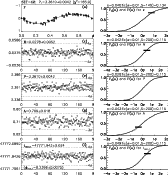 |
Figure 2:
The |
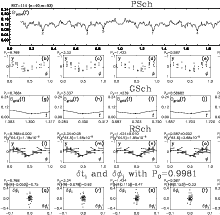 |
Figure 3: Same as in Fig. 1 for SET=114 |
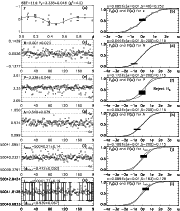 |
Figure 4:
Same as in Fig. 2 for SET=114.
Note:
e and f) |
The PSch over a long f interval
usually detects numerous frequency "candidates'' f'.
More accurate values for
at least five best f' are determined with the GSch.
The TSPA applications for real data may sometimes require
testing of a much larger number of f' detected with the PSch.
Here the limit of testing only the five best f' was chosen,
because it is convenient for the graphical representation of the results,
like in Figs. 1, 3, 5 and 7.
The PSch "model'' ![]() can not fully constrain
the modelling order K (Eqs. 1 and 2),
because yi,j closer than
can not fully constrain
the modelling order K (Eqs. 1 and 2),
because yi,j closer than ![]() in
in
![]() may
correlate in several different models.
For example, the PSch could
detect a box function or a sinusoid with
may
correlate in several different models.
For example, the PSch could
detect a box function or a sinusoid with
![]() .
The model is fixed in the GSch, e.g. if
.
The model is fixed in the GSch, e.g. if
![]() ,
GSch proceeds with a
,
GSch proceeds with a ![]() model (Eq. 1).
If PSch detects f', then
GSch tests all integer multiples of
model (Eq. 1).
If PSch detects f', then
GSch tests all integer multiples of
![]() between
between
![]() and
and
![]() ,
where
,
where
![]() is called the "overfilling factor''
and
is called the "overfilling factor''
and
![]() .
The discrete tested f set within this narrow interval is denser than in the
PSch (i.e.
.
The discrete tested f set within this narrow interval is denser than in the
PSch (i.e.
![]() ).
Standard linear least squares fits to
).
Standard linear least squares fits to ![]() with
with ![]() for every tested f in Eq. (1) (i.e. f is not a free parameter)
determine the GSch periodogram
for every tested f in Eq. (1) (i.e. f is not a free parameter)
determine the GSch periodogram
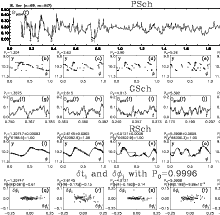 |
Figure 5:
The fifth order TSPA ( |
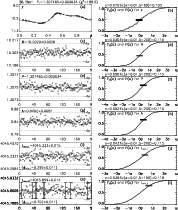 |
Figure 6:
The |
 |
Figure 7:
The first order TSPA ( |
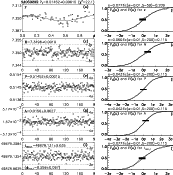 |
Figure 8:
The |
The model (Eq. 1) is nonlinear when f is a free parameter.
The RSch performs a standard Marquardt iteration
(e.g. Press et al. 1988)
to compute
![]() .
But the result of this iterative refinement
depends on the trial solution (
.
But the result of this iterative refinement
depends on the trial solution (
![]() ).
Large discrete f sets are tested with PSch and GSch only to
provide a reliable
).
Large discrete f sets are tested with PSch and GSch only to
provide a reliable
![]() for RSch.
Combining the f' detected in the GSch to
for RSch.
Combining the f' detected in the GSch to
![]() (Eq. 7) gives
(Eq. 7) gives
![]() .
While the PSch and GSch test discrete f sets,
the RSch is
continuous in f, because it utilizes the analytical properties of
.
While the PSch and GSch test discrete f sets,
the RSch is
continuous in f, because it utilizes the analytical properties of
Copyright The European Southern Observatory (ESO)